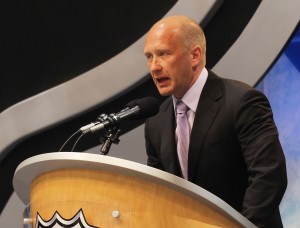This space had been reserved for a relatively sedate review of the first quarter of the Blue Jackets’ season. However, in the past 48 hours, the club has chosen to attract some serious attention, through moves both on the ice and off. Let’s ride this rocket while the fuse is still burning.

The Other Shoe Drops — Howson Era Ends
In the middle of the evening yesterday, word came out that General Manager Scott Howson had been relieved of his duties by Hockey Operations President John Davidson, and that a press conference was scheduled for the morning. I caught the news from Pierre McGuire, as he was standing between the benches at the Rangers-Bruins game — a foot or two away from Rick Nash, who was an integral part of the final chapters of Howson’s book in Columbus.
While the timing of the move is marginally intriguing, the fact of the move is not. To anyone closely monitoring the club — or anyone remotely familiar with the ins and outs of corporate transitions — this move had been in the cards for a long time. John Davidson’s hire started the clock ticking on Howson’s tenure, as Davidson immediately became The Man on the hockey side of the house, freeing Mike Priest to focus on his strengths on the business side, and usurping Howson’s function as the face of the front office from a hockey perspective. With the off-season and a lengthy lockout to review, assess and analyze, it seemed a foregone conclusion that Davidson would either take the reins himself or put his own guy in the spot, as is entirely normal and customary when these types of moves occur. While he retained the title, the Davidson hire clearly represented a significant demotion for Howson, both functionally and from an appearance standpoint. When that happens, you leave — either voluntarily sooner, or involuntarily later. That’s simple, brutal corporate reality, and I’m frankly a bit surprised that Howson did not negotiate a more graceful exit earlier.
When things like this happen, reactions tend to move to one of two extremes. People either adopt the “revisionist historian” view of the departing individual’s tenure — a “he really wasn’t that bad” approach — or they react with vitriol and relish the demise. The first approach is dishonest, while the second is simply distasteful. Lori Schmidt (@LoriSchmidt) — a top-notch (and under-appreciated) reporter for the Blue Jackets’ flagship radio station — reminds people that there is never cause to celebrate an individual losing his or her job., and that is precisely correct. We can applaud the move from an organizational perspective, but don’t relish the personal consequences.
It is entirely possible — and appropriate — to note that Howson is a good, intelligent guy, who simply made more bad decisions than good ones during his time at the helm. Hired just days before the 2007 NHL Draft — hosted in Columbus — Howson was the rational, calm reaction to the bombastic, carnival-barker style of his predecessor, Doug MacLean. The public was exhausted by repeated over-promising and under-delivering, and Howson seemingly provided the perfect antidote in this respect. A thoughtful lawyer — deliberate in both speech and action — seemed to be precisely the ticket for what ailed the organization. And it was . . . for a while. Howson brought the type of sober, analytical approach that helps when you are trying to create an organization from the vacuum that was left by a structure consisting of a single, dominant individual.
That sense of deliberation and analysis can be both a blessing and a curse — and Howson’s record reflects that. There are the notable bombs in the draft — Nikita Filatov and Stefan Legein being prime examples. But there were also some finds — Cam Atkinson in the 5th round and Matt Calvert in the 6th, for example. For other draft picks — Will Weber, T.J. Tynan, Cody Goloubef — college careers have delayed their emergence. For still others — Johansen, Jenner, Murray, Moore — it’s simply too early to make a judgment. However — correctly or incorrectly — there was a prevailing sense that the Blue Jackets’ low picks should have resulted in more players with immediate impact. Only after last year’s debacle were significant changes made in the scouting organization, and it may well be that the scrutiny of Hockey Operations led ownership to pursue Davidson. (True, Howson is credited with suggesting the name, but only after McConnell and Priest opened the search.)

While the draft verdict may be open to debate, the trade verdict is not. While his moniker of “Roster Ninja” (bestowed by Schmidt) was earned with such deals as Kris Russell for Nikita Nikitin, Antoine Vermette for Pascal LeClaire, Umberger for picks, and Mark Letestu for a 4th round pick, there were far more of the other variety. Curtis Glencross for Dick Tarnstrom, Chimera for Clark and Jurcina, Torres for Paetsch — this list goes on. Ironically, potentially some of the best deals were done last year — Foligno for Methot, getting Dubinsky, Anisimov and Erixon for Nash, Carter for Johnson and a 1st, Bobrovsky for picks. Those deals, however, came only after the steadying hand of Craig Patrick was applied to the organization. He incompletely researched the background of the Jeff Carter deal, Guy Boucher’s interest and Scott Arniel’s ability. He allowed morale — and performance — to deteriorate too far before pulling the plug on Ken Hitchcock and Arniel.
Howson’s organizational epitaph will be equally premised more on what he did not do, as it will be upon affirmative transgressions. Yes, he materially botched the way the Nash situation was handled — alienating far too many people and attracting far too much negative attention. However, at the end of the day, he got a decent return on the deal. But the Nash situation served to put sharper focus on what was an ongoing problem — the perceived tendency to over-analyze situations and a reluctance to pull the trigger when needed. Frequently, the trade deadline came and went without a significant deal — and the trades that others made suggested that those deals were available. He incompletely researched the background of the Jeff Carter deal, Guy Boucher’s interest and Scott Arniel’s ability. He allowed morale — and performance — to deteriorate too far before pulling the plug on Ken Hitchcock and Arniel. His communication style was not the Doug MacLean hyperbole, but the carefully clipped legal style was equally obfuscating and frustrating.
When all is said and done, Scott Howson performed as you would expect for someone taking their first GM position — he had the tools to make individual decisions, but could not assemble the pieces into a cohesive picture. A talent could be drafted . . . but not developed. A solid piece was acquired by trade . . . then allowed to leave via free agency or bargain basement trade. It was a reactive style that was not fitting with the opportunities that were available. So, while Howson is a smart, decent guy with integrity from here to Christmas, he just simply did not have the tools to get the job done.
Tervetuloa, Jarmo Kekalainen!
 When last night’s announcement was accompanied by notice of a 9:30 am press conference this morning, most presumed it would simply be Davidson’s formal acknowledgement of the move, announcement that a “full and exhaustive search” would be commenced, and the usual Q & A opportunities with the local press. It just goes to show — never presume when John Davidson was involved. In simultaneous press conferences in Columbus and Helsinki, the hiring of Jarmo Kekalainen as the new General Manager in Columbus was made official. Darren Dreger of TSN had suggested the name last night, but few locally thought that things were that far along. The Blue Jackets just don’t do things that way . . .
When last night’s announcement was accompanied by notice of a 9:30 am press conference this morning, most presumed it would simply be Davidson’s formal acknowledgement of the move, announcement that a “full and exhaustive search” would be commenced, and the usual Q & A opportunities with the local press. It just goes to show — never presume when John Davidson was involved. In simultaneous press conferences in Columbus and Helsinki, the hiring of Jarmo Kekalainen as the new General Manager in Columbus was made official. Darren Dreger of TSN had suggested the name last night, but few locally thought that things were that far along. The Blue Jackets just don’t do things that way . . .
Kekalainen, who by his own admission had a “brief, undistinguished” NHL career, is 46, and has been the GM for Finnish Elite League dynamo Jokerit for the past few years. He previously worked as Assistant GM for the Blues, which is where the Davidson connection comes in. He is universally regarded as having a sharp eye for talent, obviously has keen insights of the European leagues, and has an established ability — and desire — to work well with Davidson. His daughters are both American citizens, having been born here, so even the family aspect seems to be well-suited to the move. I recommend this profile to provide some background on the newest member of the Blue Jackets’ front office. Kekalainen has signed a multi-year deal, but — as is customary — further details were not disclosed. Here’s Davidson talking about the decision:
While some outsiders will quickly dismiss this move as simply another front office shuffle in Columbus, I think this one runs deeper. Davidson obviously used the off-season and the lockout to carefully assess the situation, pick his guy and put things in order. Only then was the announcement made. No room for speculation — no prospect for public rejection — no disruption in continuity of operations. Planning, organization and vision — all of the reasons Davidson was brought on board. With six weeks until the trade deadline, front offices around the league are undoubtedly scurrying, and scouting activity at NHL venues is reported at all-time highs. What this all means for the Blue Jackets in terms of specific moves is rank speculation at this point. However, the decisions made — and the way they were handled — were first-rate, giving fans reason for optimism. More importantly, with the reaction of the NHL community being uniformly positive for both the Davidson and Kekalainen hires, the process of refurbishing a tarnished organizational reputation is well underway.
Meanwhile, on the Ice . . .
Almost lost in the turmoil of the front office moves is the fact that the Blue Jackets are coming off of 120 minutes of complete hockey on the ice. Though they were not rewarded for their effort against Edmonton, the club rebounded with gusto the next night against San Jose. That 6 – 2 victory was a stunning performance in many ways. First, being the back half of a back to back, with a gut wrenching loss the night before, they had every reason to mail this one in. They didn’t. Scoring on the first shift of the game, maintaining a relentless forecheck, playing responsibly with and without the puck — it was a complete effort. When San Jose narrowed the gap to 2 after two, the Blue Jackets did not come out for the 3rd brandishing their prevent defense. Instead, they scored on the first shift of the period, and added two more — within eight seconds of each other — while remaining positionally sound on defense. They were dynamic on the power play, coldly efficient on the penalty kill and received a game performance from Steve Mason in goal. Mason made some nice saves, but also provided the customary degree of angst by allowing a marginal goal, then coming perilously close to misplaying another puck into a goal that would have transformed the game. However, he maintained his poise, and the squad demonstrated an ability to place their skates collectively on the throat of the opposition — and not let up.
Certainly, San Jose was not at top form this evening, but Columbus demonstrated aspects of the game that we have only seen in flashes. Moving as a five man unit up and down the

ice. Maintaining possession for extended periods in the offensive zone — both at even strength and on the power play. Being smart with the puck and making considered passes, rather than blind slings around the boards or across the middle. Six different Blue Jackets scored, and only three skaters came away without points. Dubinsky notched his first one. Prospal scored. Letestu banked another one. Cody Goloubef — who has thus far outdone both David Savard and Nick Holden for a slot on the big club — got his first career goal. Calvert was terrific, as were Brassard and Foligno. It was the kind of “scoring by committee” that everyone knew the club would need coming into the season.The mere fact of the victory was nice, but not earth-shattering by itself. What you could not grasp unless you were there watching was the energy, the precision and the focus that the players brought to a game that everyone had likely written off — except them. It is a style of play that we have not seen in Columbus, and the taciturn Todd Richards almost gave way to a smile in discussing how things came together. Indeed, you could well argue that it is a style of play that could not happen on a Rick Nash-dominated squad. That, however, is a debate for another day.
The Blue Jackets now embark on a six-game road trip that could serve as the poster child for realignment. Los Angeles, Phoenix, Anaheim, Detroit, St. Louis, Chicago — with two back-to-backs included. Such is post-lockout life. However, such road trips can work in one of two ways for a club like the Blue Jackets: either season shattering futility, or a chemistry-building experience that sees the team gel and prosper. The club has had both experiences out west, and while the former have historically outnumbered the latter, the fact that Columbus enters the trip playing its best hockey of the season, with a few days of rest in the bank, bodes well for the results. Time will tell. Stay tuned.